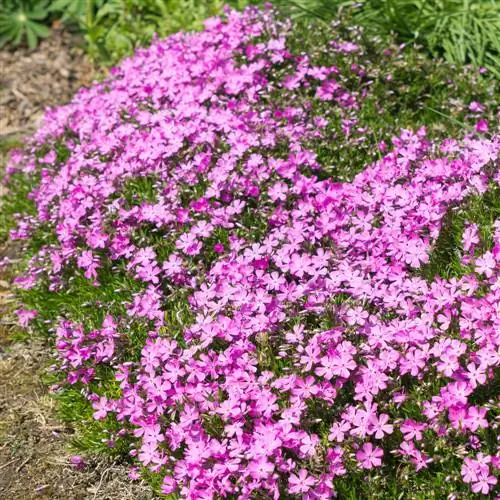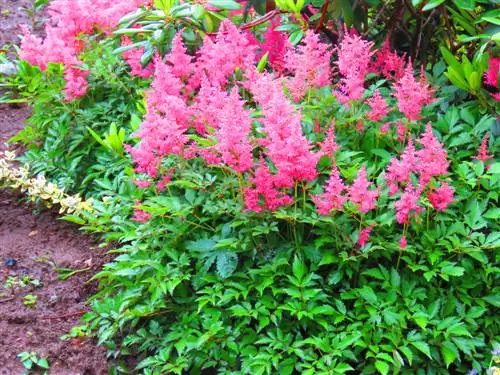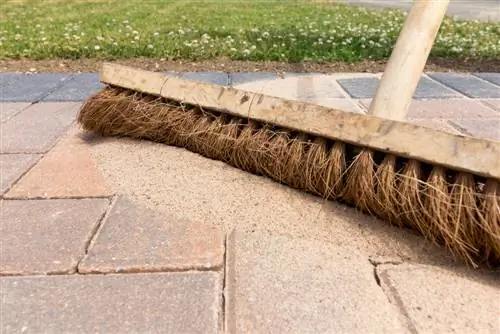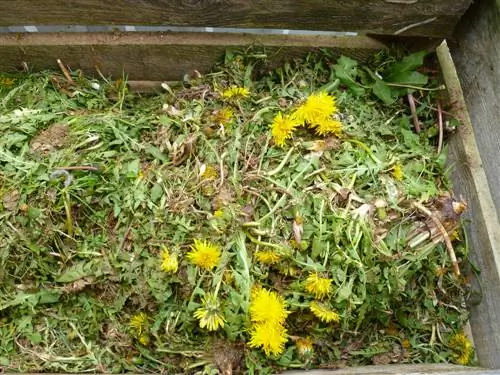- Author admin [email protected].
- Public 2023-12-16 16:46.
- Last modified 2025-01-23 11:22.
If a garden has not been tilled for a long time, groundweed and other wild plants often stubbornly overgrow entire corners of the garden. Dandelions with their bright yellow flowers undoubtedly look pretty in meadows, but they are less popular with amateur gardeners. It is very effective to cover the weeds with a tarpaulin or weed fleece and simply starve them out. You can find out how to do this in the following article.

How to cover weeds with a tarp?
To cover weeds with a tarp, you should first pull visible weeds, smooth the surface and spread the breathable, water-permeable tarp. Cut cross-shaped holes for plants and cover the tarpaulin with bark mulch, wood chips or gravel.
Weeds are prevented from growing
When installed correctly, the tarpaulin does not let in any sunlight. This prevents photosynthesis and causes the weeds to die. If there is a lack of light, the seeds will not germinate. Even green shoots such as groundweed are reliably destroyed.
Weed film is breathable and water-permeable. Plants planted in a targeted manner are therefore supplied with sufficient nutrients and the soil is aerated. Heat and moisture are stored and sensitive plants get a real growth kick, and not just in spring.
Where can weed film be used?
The areas of application of this helper in the fight against annoying greenery are diverse. You can choose the material:
- in useful and ornamental plant beds,
- under hedges,
- in the rock garden
- in the bank area of the garden pond
- under pavement
embarrassed.
Which foil is the right one?
There is a suitable weed tarpaulin for every application:
| Weight per square meter | Application |
|---|---|
| 50 | Perfect for the kitchen garden |
| 80 | Works well on rooted weeds. Good separating fleece between soil and beds that are mulched or covered with gravel. |
| 120 | Optimall for heavy weed occurrence on slopes or in rock gardens. |
| 150 | Professional quality that is laid under pavement that is driven on. |
Laying weed fleece correctly
Laying weed tarpaulin is quite easy:
- First pull out all visible weeds.
- Smooth the surface and spread the tarp.
- Those places that are to be planted, make cross-shaped cuts.
- Insert plants.
- Cover garden foil. Bark mulch, wood chips or gravel are suitable for this.
If you lay the weed tarpaulin under paving stones, you must also attach the film with ground anchors. Only then are the stones laid.
Tip
Where there is light, there is shadow. Unfortunately, this also applies to weed tarpaulins. Beneficial insects such as earthworms thrive under the cover because leaves and other plant material no longer rot in the soil. For mice, however, there is a paradise under the tarpaulin. They hide underneath and nibble on the roots undisturbed. Overgrown with greenery, you often only discover the pests when the plants wither.






